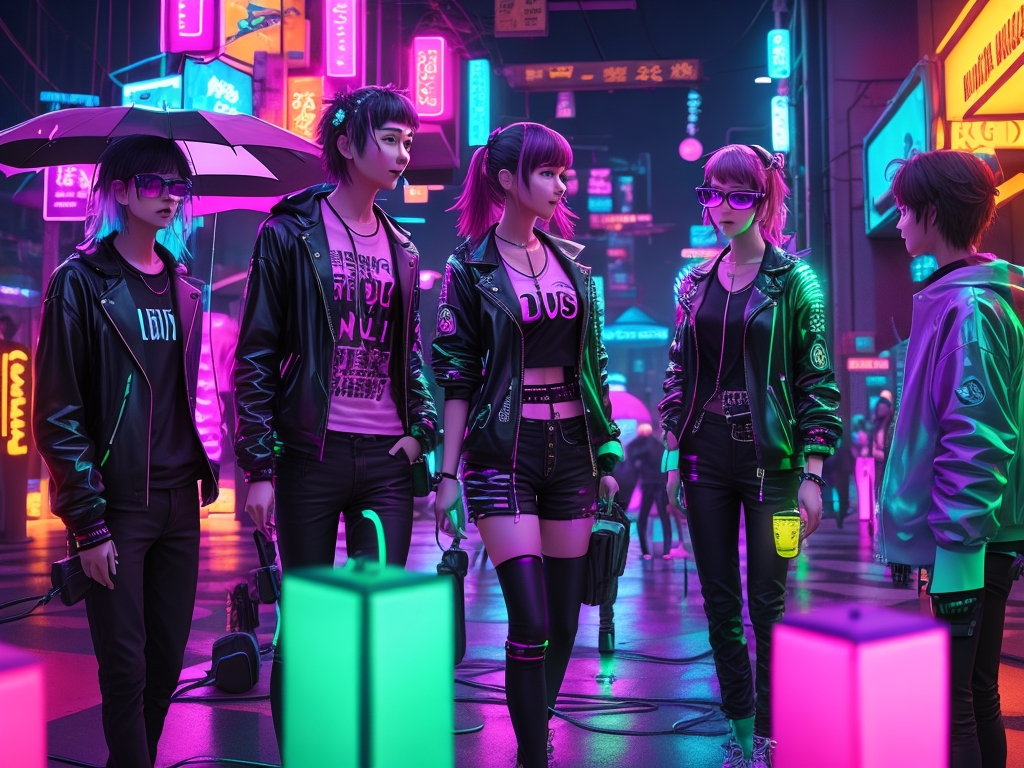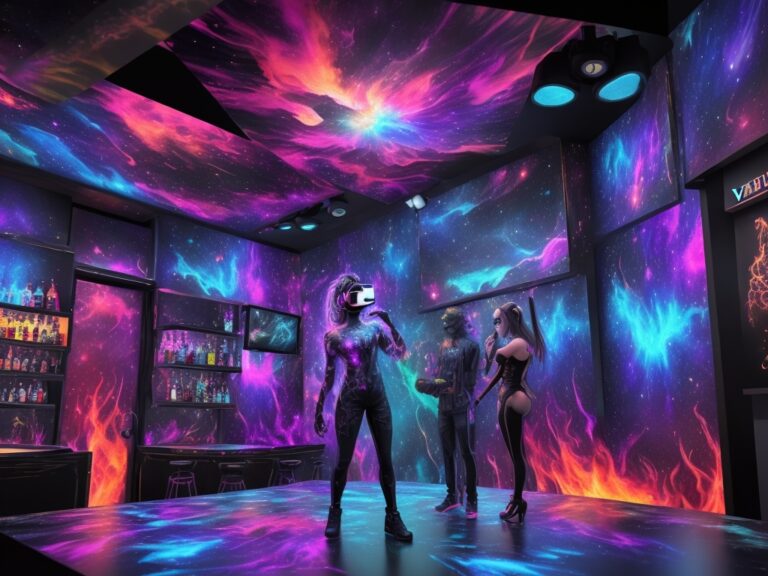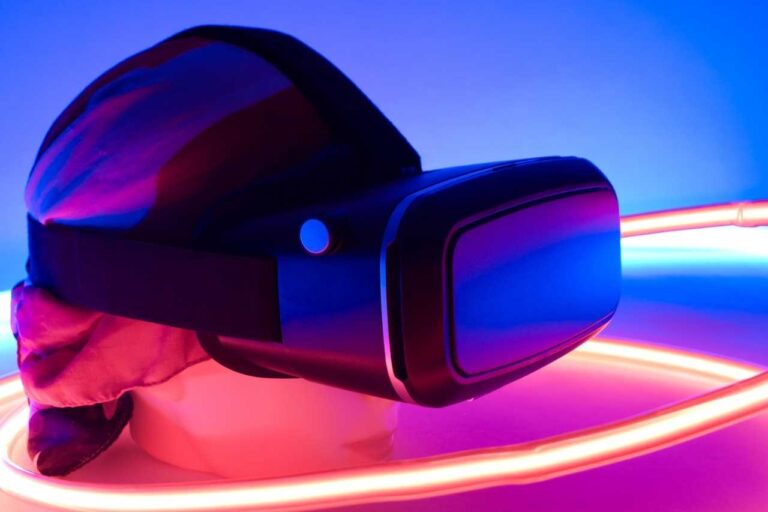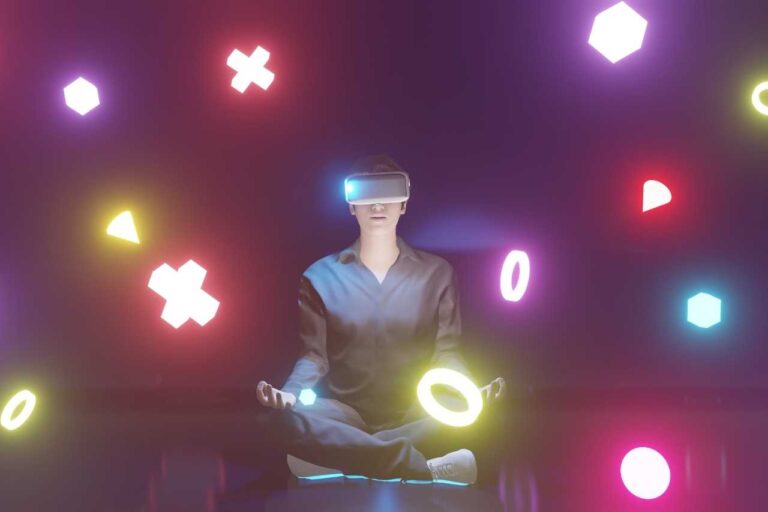How Does Virtual Reality Help To Make Experience More Inclusive?
How Does Virtual Reality Help To Make Experience More Inclusive? Virtual reality is a technology that allows people to experience things in a completely immersive way. This can be useful for making experiences more inclusive for everyone, regardless of ability or background.
Key Takeaways:
- Virtual reality (VR) allows users to visualize, explore, manipulate, and interact with objects in computer-generated environments.
- VR promotes inclusivity by helping people with disabilities feel included and part of a team.
- VR makes work experiences more accessible and inclusive by providing an immersive environment for collaboration and learning.
- Diversity focuses on who is present in a room, while inclusion focuses on whether everyone’s ideas have been heard.
- A McKinsey study found that sentiment towards diversity was 52% positive and 31% negative, while sentiment towards inclusion was 29% positive and 61% negative.
- Inclusion involves fairness, equal opportunity, and a sense of belonging within an organization.
- McKinsey’s survey found that negative sentiment around equality ranged from 63% to 80% across industries, and negative sentiment around openness of the working environment ranged from 38% to 56%.
- VR training may be a potential solution to elicit empathy and promote inclusion within organizations.
- The D&I tech industry is growing, with a market size that is expanding.
- VR technology is being used by companies to create immersive experiences that promote diversity and inclusivity in the workplace.
- VR can be used in the workplace to provide a safe and non-judgmental environment for employees to practice inclusive behavior.
- Inclusivity in the workplace is important because lack of inclusivity can have negative effects on employees and the company.
- VR can create an immersive experience that promotes inclusivity by allowing employees to experience different perspectives and understand the challenges faced by marginalized groups.
- VR can be used in diversity training to provide a more effective and engaging way of learning about diversity and inclusivity.
- Implementing VR in the workplace can be challenging, including issues with cost and accessibility of VR technology.
- Companies can overcome these challenges by finding ways to make VR more accessible and cost-effective.
- There are real-life examples of companies using VR to promote inclusivity in the workplace, including case studies that demonstrate the effectiveness of VR in creating inclusive work environments.
- VR provides more inclusive participation opportunities for students, especially those with special learning needs or disabilities like dyslexia.
- VR environments offer unique features that help students overcome the obstacles they typically face in a standard school setting.
- The use of VR in classrooms benefits the entire class, as it allows everyone to contribute in new ways, promoting peer-to-peer communication and collaboration.
- VR has become a highly effective method of training, particularly in areas related to societal issues such as racism, sexism, and discrimination.
- VR provides a safe environment for trainees to learn and make mistakes without pressure from examiners or peers.
- Diversity and inclusion (D&I) training is crucial for promoting understanding, acceptance, and integration in society.
- VR allows trainees to learn about D&I in a safe space, overcoming the fear of making mistakes or appearing ignorant.
- According to a 2020 PwC study, 75% of VR trainees considered the learning experience a “wake-up call” regarding their own inclusivity behaviors in the workplace.
- VR training is successful because it deeply connects with trainees on an emotional level, making them more likely to retain information compared to traditional methods.
- Trainees in VR environments are 3.75 times more emotionally connected to the content, enhancing cognitive and behavioral learning.
- VR training is more effective when trainees are in low-pressure environments and free from distractions, allowing them to reflect on past experiences and retain information more successfully.
- VR is being used in various industries, including the construction, medical, and automotive industries.
- VR is also used for efficient product development, allowing for the creation and testing of prototypes without the need for physical resources.
- Large companies like Boeing are using VR to test different designs before investing in production.
- VR helps make work experiences more inclusive by providing immersive and interactive training opportunities.
- The workplace is evolving rapidly, and businesses are incorporating VR to keep up with new trends.
- VR is a rapidly-growing field of gaming and entertainment technology that allows users to explore hyper-realistic and fully immersive computer-generated environments.
- VR can be incorporated into theme park rides, large-scale attractions, and at-home experiences.
- Approximately 66 million VR users are in the United States, and this number is expected to continue growing.
- While VR offers unique experiences, it may not be accessible for all users, including those who are Deaf or hard of hearing (DHH).
- VR experiences use both visual and auditory cues to create a realistic environment, including dialogue, sound effects, and other audio elements.
- To provide equitable experiences for DHH users, VR developers should incorporate assistive technologies like closed captioning.
- Closed captions represent the spoken text and audio elements of a video or video game.
- In traditional formats, closed captions appear on-screen in a fixed location, but in VR, there are challenges in implementing captions due to its 360° nature.
- There are two primary options for placing VR closed captions: head-locked, where captions follow the user’s head movements, and fixed, where captions remain locked in space.
Introduction to virtual reality
Virtual reality (VR) is revolutionizing our experiences, making them more immersive and inclusive. In this introduction, we’ll dive into the world of VR, exploring what it is and how it works. Additionally, we’ll uncover the exciting potential of VR in the workplace, shedding light on its transformative capabilities. Supported by compelling facts and figures, let’s embark on a journey through the limitless possibilities that virtual reality offers.
Brief explanation of what VR is and how it works
Virtual Reality (VR) is an immersive technology that provides users a computer-generated environment that feels real. It works by using headsets or goggles to display 3D visuals, and motion tracking sensors to detect user movements. VR can also incorporate sound and touch, further enhancing presence in the virtual environment.
This tech has applications beyond gaming and entertainment. It can be used for training purposes in various industries. It increases efficiency and effectiveness, while reducing risks and costs.
VR also promotes inclusivity in the workplace. It connects people from different locations, breaking down barriers of distance. It also helps people with disabilities feel included and part of a team, by providing accessible tools and experiences.
In conclusion, VR holds great potential for promoting inclusivity in organizations. It can create empathy-building training programs, impactful educational settings, and accessible options for all users’ needs.
Explanation of how VR can be used in the workplace
Virtual Reality (VR) is now popular. It has great potential for various uses, including the workplace. It permits people to experience computer-generated scenarios that copy real-life. In the workplace, VR can help in multiple ways – to boost productivity, training, and cooperation.
One way to use VR in the workplace is for immersive training. Typical training can involve reading manuals or attending talks, which isn’t always successful. With VR, employees can do hands-on simulations that mirror real-world situations. For example, they can practice using machinery or handling dangerous materials in a safe, controlled virtual world. This enables them to gain practical experience without any risk of injury or damage to equipment.
VR can also be used for virtual meetings and collaboration. With improved communication tech, remote work is more usual – but it can limit collaboration and involvement. Through VR, groups can enter a shared virtual space where they can interact with colleagues like they are physically present. This helps inclusiveness by offering equal chances to join, no matter where they live.
VR can also make inclusive environments for individuals with disabilities. People with mobility constraints or other disabilities may struggle to engage in certain activities or access certain spaces within the workplace. But with VR, they can virtually navigate spaces or take part in activities that would otherwise be hard or impossible.
To sum up, VR has lots of potential to change the workplace. It can give immersive training experiences and promote inclusivity among employees. If organizations leverage this tech, they can raise productivity and make more engaging and accessible work environments.
How VR promotes inclusivity in the workplace
Virtual reality (VR) is revolutionizing the workplace by fostering inclusivity and creating a sense of belonging. In this section, we will explore how VR promotes inclusivity in professional settings. From generating immersive environments for collaboration and learning to empowering individuals with disabilities to feel fully included and valued, VR is breaking barriers and enhancing diversity in the workplace.
Creating an immersive environment for collaboration and learning
Virtual Reality (VR) tech creates a captivating space for workplace learning and collaboration. With VR, people can enter a simulated world with virtual objects and act with them in real-time. This immersive atmosphere increases involvement and gives more interactive and dynamic chances to work together. By making a real-like environment, VR encourages activity, knowledge sharing, and problem-solving for team members.
In this immersive setting, staff can join virtual meetings, workshops, or training sessions without being geographically limited. They can collaborate on tasks, come up with ideas, and give feedback as if they were in the same room. This level of immersion promotes active participation and improves communication between teams. Additionally, VR offers a safe space for employees to practice delicate conversations without the fear of negative consequences.
Furthermore, VR breeds an inclusive workplace by tackling barriers faced by disabled people. Mobility issues may make it difficult for those with physical disabilities to access physical workspaces or take part in some activities. However, VR technology eliminates these barriers as everyone can fully join virtual experiences regardless of their physical abilities. VR lets disabled people feel part of a team by providing equal access to collaborative opportunities.

By making an immersive atmosphere for collaboration and learning, VR contributes to building diverse and inclusive organizations. Diverse teams bring together a range of outlooks and experiences, leading to increased creativity and innovation. Inclusive workplaces guarantee that people feel respected and valued for their unique contributions. With VR tech, organizations can close gaps between different cultures and backgrounds by promoting understanding and empathy among employees.
To make the most out of VR in encouraging inclusivity at work, organizations should invest in training programs that use this tech to induce empathy and improve cultural competence. By introducing staff to immersive simulations depicting scenarios involving diversity-related issues such as unconscious bias or discrimination, people can develop a deeper understanding of the struggles faced by marginalized groups. This emotional connection and improved learning experience can cause more inclusive behaviors and attitudes in the workplace.
Helping people with disabilities feel included and part of a team
Virtual Reality (VR) has shown to be a powerful aid in helping people with disabilities. By creating immersive surroundings, VR allows anyone to experience learning and collaboration equally. This way, individuals with disabilities can fully take part in group activities and use their special skills and perspectives.
In these virtual worlds, persons with disabilities have the same opportunities as everyone else. They can get past physical barriers and move around, making them feel welcomed and accepted. By being able to take part in teamwork, they not only feel appreciated but can also improve their abilities.
To promote inclusivity, VR training can use empathy-building techniques. Through VR experiences, people can gain understanding of other people’s perspectives and challenges faced by those with disabilities. This builds empathy and helps create a culture of acceptance in the workplace.
Organizations can also take steps to include assistive technologies in VR experiences. For instance, closed captioning can be added to simulations, ensuring deaf or hard of hearing people can participate and comprehend verbal instructions. Additionally, altering caption placement in the virtual environment can help those with visual impairments understand information better.
The importance of diversity and inclusion in organizations
Diversity and inclusion in organizations are crucial for success. In this section, we will explore the significance of fostering a diverse and inclusive environment. We will distinguish between diversity and inclusion, highlighting the importance of both. Additionally, we will touch upon the challenges organizations face when it comes to promoting and addressing inclusion. Join us as we dive into the essential role of diversity and inclusion in driving organizational growth and innovation.
Distinguishing between diversity and inclusion
Diversity and inclusion are two related, yet separate concepts in organizations. Diversity is about having people from different backgrounds, experiences, and perspectives. Inclusion is about developing an atmosphere where everyone feels respected and valued.
To comprehend the difference between diversity and inclusion, take a look at their key characteristics:
| Diversity | Inclusion |
|---|---|
| Unique identities, backgrounds, and experiences | Equal possibilities and respect for all |
| A range of demographics | A safe atmosphere and sense of belonging |
| More creativity and innovation | A space that respects diverse perspectives |
Diversity initiatives focus on diversifying the workforce through recruitment philosophies. Inclusion efforts go beyond representation – they create an environment of inclusivity. Diversity is about who is in the organization, while inclusion is about how they are treated.
Fully understanding the distinction between these concepts is crucial in creating an inclusive workplace. It requires going past quotas and tokenism by promoting actual inclusivity. Organizations should recognize the individual abilities of each member of a diverse staff and build an environment where their voices are respected and valued.
By leveraging the diversity in the workforce and having an inclusive culture, organizations can benefit from a wide range of ideas, perspectives, and experiences. This encourages innovation, improves decision-making, and improves the overall success and sustainability of the organization.
In a rapidly altering world where diverse perspectives are essential for business growth and success, organizations must strive to be both diverse and inclusive. By accepting diversity in all forms and having an inclusive workplace culture, they can unlock the full potential of their employees and develop an environment where everyone can thrive. Join the journey of diversity and inclusion today to make sure no one misses out on opportunities for growth, collaboration, and success.

Challenges faced in addressing inclusion
Addressing inclusion in organizations can be complex. Creating an environment where people from different backgrounds feel valued is key. Overcoming biases and stereotypes is a challenge. This involves education, awareness, and implementing policies that promote inclusivity.
Ensuring equal opportunities for all employees is another challenge. Inclusive organizations provide support systems and accommodations for everyone to thrive. This could include flexible work arrangements, accessible spaces, and sensitivity training.
Fostering a culture of inclusion takes time and effort. Leaders must model inclusive behaviour and encourage open dialogue. Employees should feel empowered to share perspectives without fear. This leads to higher engagement, productivity, and innovation.
Addressing inclusion is not a one-size-fits-all solution. Each organization will face unique challenges. However, by recognizing the importance of diversity and actively creating an inclusive workplace culture, organizations can create a more equitable and supportive environment.
The potential of VR training to elicit empathy and promote inclusion
Virtual reality (VR) training holds tremendous potential in fostering empathy and promoting inclusion. As we explore the topic, we will witness the growing demand and market size for diversity and inclusion (D&I) tech industry. The power of VR lies in its ability to create immersive experiences, enabling individuals to step into others’ shoes and understand diverse perspectives. Join us as we explore the transformative effects of VR training in cultivating empathy and shaping a more inclusive society.
Growing market size for D&I tech industry
The D&I tech industry, especially VR, is booming. VR provides a unique and immersive experience to encourage diversity. Organizations use it to address issues and make inclusive workplaces.
Demand for VR applications to promote D&I is rising. Investment in VR training programs is increasing too. Special VR platforms are being tailored for D&I. Also, specialized hardware and software are available. VR is gaining recognition as a tool to foster empathy and acceptance.

The market size for D&I tech is growing. Organizations see the potential of VR in promoting inclusivity and improving culture. This shift requires more interactive approaches to tackle diversity.
The market size reflects the need for innovative D&I solutions. Thanks to technology, now there are more ways to create inclusive environments. So, organizations are investing in D&I tech products and services. Consequently, we can expect advancements that further support diversity.
Case studies and examples of VR promoting inclusivity in the workplace
Virtual reality (VR) has shown it can help make workplaces more inclusive. Through examples, we can see VR technology can create experiences with no physical restrictions. This gives everyone equal opportunities in the workplace.
VR can be used to teach employees. It can show them how to interact with people from different backgrounds. This helps people be more understanding and work better as a team, creating an inclusive environment.
VR can also give learning experiences to fit different learning styles. Traditional methods like lectures may not work with everyone. VR can let people learn through practical experience, making it easier for everyone to learn.
VR as an inclusivity tool in the classroom
Virtual reality (VR) is revolutionizing the education landscape by serving as an inclusivity tool in the classroom. This section will explore the benefits of VR for students with special learning needs or disabilities, as well as how it promotes peer-to-peer communication and collaboration. With VR, educational experiences become more immersive, engaging, and tailored to meet the diverse needs of students, fostering a more inclusive and enriching learning environment.
Benefits for students with special learning needs or disabilities
Virtual Reality (VR) can be a major benefit for students with special learning needs or disabilities. It provides an immersive learning experience tailored to individual student’s abilities and needs. Here are some of the advantages:
- VR brings increased engagement due to its interactive atmosphere.
- Personalised learning opportunities, allowing students to learn at their own pace.
- Sensory stimulation enhanced by multi-sensory experiences.
- Accessibility improved, with physical barriers being broken down.
- Social skills development enabled via controlled environments.
The use of VR in special education classrooms has been seen to build independence, self-confidence, and offer empowerment to students with disabilities. Educators can create inclusive learning environments with this technology, engaging all students and supporting their educational journey. VR: Uniting students in a virtual world; a place where disabilities don’t limit, but collaboration and communication do.
Promoting peer-to-peer communication and collaboration
VR provides an amazing virtual space for colleagues to engage in real-time conversations and share info. Team members can join forces to work on projects, by sharing documents and manipulating virtual objects. Voice chat features in VR facilitate direct communication, making collaboration simpler and more effective. Plus, everyone has the same access to the digital environment, enabling different backgrounds to add their unique perspectives.
Moreover, the interactive nature of VR increases engagement between team members, elevating peer-to-peer communication and collaboration. This technology also grants individuals the freedom to freely express their thoughts and ideas. It goes beyond traditional methods, permitting new forms of interaction that disregard physical boundaries and individual differences. VR even allows people with special needs or disabilities to actively participate in collaborations without encountering any obstacles. This inclusive atmosphere helps build strong relationships among colleagues, boosting cooperation and productivity.
To show the power of VR in promoting peer-to-peer communication and collaboration, look at this example: A multinational company adopted VR training programs for its personnel all over the world. This enabled employees from different countries to come together virtually, to work on projects, exchange ideas, and solve problems together. Not only did this bridge geographical distances, but it also let people from varied cultural backgrounds to collaborate without the boundaries of time zones or travel charges. By providing a platform for efficient communication and collaboration, VR made a big contribution to creating an inclusive workplace.
VR training in society is where empathy is a virtual reality and inclusivity is a tangible result.
VR training for diversity and inclusion in society
VR training for diversity and inclusion in society takes a transformative approach by creating a safe environment for understanding and acceptance. Additionally, the emotional connection and enhanced learning experienced through virtual reality foster a more inclusive society.
Creating a safe environment for understanding and acceptance
Virtual Reality (VR) technology in the workplace has unlocked new ways to create a safe atmosphere that encourages understanding and acceptance. With VR, people can enter virtual environments and see things from different perspectives, promoting inclusivity.
Users can take part in simulations that challenge their preconceived ideas and prejudices. Through these experiences, people can gain insight into the struggles of others. Also, the immersive nature of VR training helps to create a secure learning atmosphere, where individuals can grow compassion and empathy.
Uniquely, VR can also elicit emotional responses from users. Through crafted scenarios, VR training can spark genuine emotions, helping users bond with the experiences of others. This emotional bond strengthens the learning process and helps people comprehend and accept each other.
For society to be diverse and inclusive, we need a safe environment where people understand and accept one another. Organizations can use VR technology as a training tool, so people can experience different perspectives firsthand. This helps to break down barriers, combat biases, and create a space where empathy, respect, and acceptance flourish.
In conclusion, virtual reality has great potential as a tool to create safe spaces for understanding and acceptance. Through immersive experiences that evoke emotions and encourage empathy, VR training can play a huge role in fostering inclusivity in the workplace and society. VR training: Where emotions meet education, creating an immersive experience that enhances learning and develops emotional connections.
Emotional connection and enhanced learning in VR training
VR training is a fresh approach that encourages emotional connection and improved learning. It uses immersive experiences to let users become fully engaged. In a simulated environment, individuals gain a sense of presence and engagement, which creates understanding and empathy.
VR training gives participants a chance to confront their prejudices and ideas. For example, users can become people from different backgrounds or with disabilities, and gain direct insight into their situations. This promotes inclusive behavior in the workplace through empathy.
Additionally, VR training provides an interactive and exciting learning experience. Through virtual simulations, employees practice skills and get instant feedback in a secure setting. This experiential approach boosts knowledge and skill growth, helping people comprehend diverse perspectives and build inclusive behaviors.
Incorporating emotion into the learning process is critical for lasting impact. Experiments have shown that events that evoke emotion are more memorable and successful in changing behavior. By using emotion in VR training, organizations can produce powerful emotional responses that improve the learning process and make it more effective.
Overall, emotional connection and effective learning in VR training are vital for promoting diversity and inclusion. VR technology has the potential to produce positive changes within organizations and society, by giving people immersive experiences that foster empathy, understanding, and skill growth.
VR in various industries for inclusive work experiences
Virtual Reality (VR) is revolutionizing various industries by fostering inclusive work experiences. From training employees in the workplace to enhancing product development and testing, VR offers immense benefits. According to the reference data, VR enables immersive training, allowing employees to gain valuable skills in a safe and controlled environment. Additionally, it facilitates efficient product development and testing, streamlining the process and reducing costs. Discover how VR is transforming these industries for the better.
Training purposes in the workplace
VR offers an enhanced training experience with hands-on learning scenarios, which promote better retention and knowledge transfer. It creates realistic simulations, allowing employees to practice tackling complex tasks in a safe environment. This cost-effective, engaging, and interactive approach caters to individual needs, while facilitating collaboration among remote colleagues.
Moreover, successful case studies demonstrate its effectiveness, from reducing workplace accidents and improving productivity to efficient product development and testing. This proves that with VR, inclusivity is more than just a buzzword – it’s a virtual reality.
Efficient product development and testing
VR offers an efficient way to create product development and testing processes. This includes:
- Crafting a virtual test environment. Developers can build a functional reproduction of their product to explore different characteristics, features, and user journeys in a regulated space.
- Undertaking user tests in VR. This helps companies replicate real-world conditions and receive feedback from users without having to physically construct the product.
- Rapid prototyping and iteration. VR enables quick prototyping, enabling developers to produce numerous versions of the product swiftly. This iterative process pinpoints any mistakes or areas for improvement early on, conserving time and expenditures during the development cycle.
By utilizing these three steps, organizations can optimize their product development and testing processes while decreasing costs associated with physical prototyping and testing. Plus, this technology gives stakeholders a chance to be actively involved in the development process. Through virtual simulations, organizations can incorporate input from stakeholders at the beginning, thus guaranteeing that all points of view are taken into account when forming inclusive products.
Pro Tip: To ensure your VR simulations reflect the desired end-user experience, involve representatives from diverse backgrounds during the design stage. Their knowledge will assist in uncovering potential hindrances or discriminatory elements that may have gone unnoticed.
Making VR more accessible for all users
Virtual reality (VR) holds immense potential for immersive experiences, but ensuring accessibility for all users remains a priority. In this section, we will explore how VR can be made more accessible by addressing the challenges faced by deaf or hard of hearing users. We will also delve into the incorporation of closed captioning in VR experiences and discuss placement options to enhance the accessibility of VR closed captions. Join us as we uncover ways to make the VR experience more inclusive for everyone.
Challenges for Deaf or hard of hearing users
Deaf and hard of hearing individuals face unique challenges when using virtual reality (VR). Audio elements are often required for an immersive experience, hindering their ability to comprehend VR content. To tackle this, developers and designers must consider alternative modes of communication. Visual cues and text-based instructions can improve comprehension and provide equal access. Additionally, closed captioning options should be included in VR experiences.
The customization of captions is also key. Designers must keep visibility, readability, and integration into the virtual world in mind. Offering customizable settings for captions will allow users to personalize their experience. By embracing these solutions, VR developers and designers can create a more inclusive and accessible virtual world.
Incorporating closed captioning in VR experiences
Closed captioning in VR experiences involves adding text-based subtitles or descriptions. This makes VR experiences more inclusive and accessible for those who are deaf or hard of hearing. Written captions are shown alongside visuals and audio, so all users can fully engage with the virtual environment.
Incorporating closed captioning ensures that deaf or hard of hearing individuals can understand the audio content. It helps bridge the communication gap by providing text-based subtitles that sync with the visuals and sounds. This enables users to follow conversations, dialogues, and other audio cues, making their experience even better.
Developers need to create captioning systems that blend with existing VR platforms and applications. Options include placing captions at specific locations within the virtual environment or using a fixed screen space for displaying captions throughout the experience.
Organizations can make their VR content accessible to individuals who are deaf or hard of hearing by incorporating closed captioning. This opens up new opportunities for them to participate in virtual training, simulations, collaborations, and immersive learning experiences. Closed captioning technology within VR enhances its potential for fostering inclusion and equal access.
Caption this: Finding the perfect spot for VR closed captions, because inclusivity is all about placement.
Placement options for VR closed captions
Including placement choices for virtual reality closed captions is essential for accessibility for deaf or hard of hearing users. These options are key to making an inclusive and immersive atmosphere for all.
Floating text could be used in the user’s view. This means they can read dialogue without obstructing their view. Alternatively, on a fixed screen within the virtual world. This gives a consistent spot for users to read captions while still submerging themselves in the experience.
An alternate way is to integrate captions directly into characters or objects in the virtual environment. Creating a seamless and natural viewing experience, with users associating dialogue to specific elements. Plus, some VR systems have caption customization, allowing the user to adjust font size, color, and background opacity.
Sound-based cues can sync with captions, giving more context and info about what’s going on in the virtual environment.
This helps individuals with hearing impairments to be included in experiences, and promotes inclusivity and fairness in the digital landscape. Furthermore, appropriate placement of VR closed captions benefits everyone, improving accessibility and usability. By considering different placements based on user needs, developers can make an inclusive and immersive environment for everyone.
Conclusion
Virtual reality has shown to be a powerful tool in creating a more inclusive experience. By immersing users in a simulated environment, it bridges the gap between different individuals. This is especially effective for those with disabilities or limitations. Virtual reality can create a shared experience where physical barriers don’t matter.
It offers users the chance to explore new perspectives and gain understanding of others. Immersive visuals, audio, and tactile feedback simulate situations that would otherwise be impossible for certain individuals. For example, someone with a physical disability can experience activities such as mountain climbing or playing a sport through VR. This enhances their empowerment and promotes inclusivity.
Multiplayer virtual reality environments bring people of diverse backgrounds together. This helps to foster empathy by allowing individuals to experience life from different perspectives. For example, through VR, someone can step into the shoes of a person with a visual impairment and gain a deeper understanding of the challenges they face.
One example of virtual reality’s impact on inclusivity is that of a paraplegic who was able to experience skiing again. They used a VR system to simulate skiing down a mountain, which gave them joy and accomplishment. This shows that with technology, barriers can be overcome and inclusive experiences can be created.
To conclude, virtual reality has the potential to make experiences more inclusive. It eliminates physical barriers, fosters empathy, and creates shared experiences. Through stories like the paraplegic skier, we can see the power of VR in breaking down barriers and creating inclusive experiences for all.
Some Facts About How Virtual Reality Helps Make Experiences More Inclusive:
- ✅ Virtual reality (VR) allows users to visualize, explore, manipulate, and interact with objects in computer-generated environments. (Source: https://www.rjwala.com/2022/03/how-does-virtual-reality-help-to-make.html)
- ✅ VR promotes inclusivity by helping people with disabilities feel included and part of a team. (Source: https://www.rjwala.com/2022/03/how-does-virtual-reality-help-to-make.html)
- ✅ VR makes work experiences more accessible and inclusive by providing an immersive environment for collaboration and learning. (Source: https://www.spiceworks.com/hr/diversity-inclusion/articles/virtual-reality-inclusive-workplace/)
- ✅ Diversity focuses on who is present in a room, while inclusion focuses on whether everyone’s ideas have been heard. (Source: https://www.spiceworks.com/hr/diversity-inclusion/articles/virtual-reality-inclusive-workplace/)
- ✅ A McKinsey study found that sentiment towards diversity was 52% positive and 31% negative, while sentiment towards inclusion was 29% positive and 61% negative. (Source: https://www.spiceworks.com/hr/diversity-inclusion/articles/virtual-reality-inclusive-workplace/)
- ✅ Inclusion involves fairness, equal opportunity, and a sense of belonging within an organization. (Source: https://www.spiceworks.com/hr/diversity-inclusion/articles/virtual-reality-inclusive-workplace/)
- ✅ McKinsey’s survey found that negative sentiment around equality ranged from 63% to 80% across industries, and negative sentiment around openness of the working environment ranged from 38% to 56%. (Source: https://www.spiceworks.com/hr/diversity-inclusion/articles/virtual-reality-inclusive-workplace/)
- ✅ VR training may be a potential solution to elicit empathy and promote inclusion within organizations. (Source: https://www.spiceworks.com/hr/diversity-inclusion/articles/virtual-reality-inclusive-workplace/)
- ✅ The D&I tech industry is growing, with a market size that is expanding. (Source: https://www.spiceworks.com/hr/diversity-inclusion/articles/virtual-reality-inclusive-workplace/)
- ✅ VR technology is being used by companies to create immersive experiences that promote diversity and inclusivity in the workplace. (Source: https://www.someonestar.in/2023/04/how-does-virtual-reality-help-to-make.html)
- ✅ VR can be used in the workplace to provide a safe and non-judgmental environment for employees to practice inclusive behavior. (Source: https://www.someonestar.in/2023/04/how-does-virtual-reality-help-to-make.html)
- ✅ Inclusivity in the workplace is important because lack of inclusivity can have negative effects on employees and the company. (Source: https://www.someonestar.in/2023/04/how-does-virtual-reality-help-to-make.html)
- ✅ VR can create an immersive experience that promotes inclusivity by allowing employees to experience different perspectives and understand the challenges faced by marginalized groups. (Source: https://www.someonestar.in/2023/04/how-does-virtual-reality-help-to-make.html)
- ✅ VR can be used in diversity training to provide a more effective and engaging way of learning about diversity and inclusivity. (Source: https://www.someonestar.in/2023/04/how-does-virtual-reality-help-to-make.html)
- ✅ Implementing VR in the workplace can be challenging, including issues with cost and accessibility of VR technology. (Source: https://www.someonestar.in/2023/04/how-does-virtual-reality-help-to-make.html)
- ✅ Companies can overcome these challenges by finding ways to make VR more accessible and cost-effective. (Source: https://www.someonestar.in/2023/04/how-does-virtual-reality-help-to-make.html)
- ✅ There are real-life examples of companies using VR to promote inclusivity in the workplace, including case studies that demonstrate the effectiveness of VR in creating inclusive work environments. (Source: https://www.someonestar.in/2023/04/how-does-virtual-reality-help-to-make.html)
- ✅ VR has become a highly effective method of training, particularly in areas related to societal issues such as racism, sexism, and discrimination. (Source: https://www.weschool.com/stories/how-these-teachers-used-virtual-reality-as-an-inclusivity-tool-in-the-classroom/)
- ✅ VR provides a safe environment for trainees to learn and make mistakes without pressure from examiners or peers. (Source: https://www.weschool.com/stories/how-these-teachers-used-virtual-reality-as-an-inclusivity-tool-in-the-classroom/)
- ✅ Diversity and inclusion (D&I) training is crucial for promoting understanding, acceptance, and integration in society. (Source: https://labs.uk.barclays/learning-and-insights/news-and-insights/technology/how-virtual-reality-training-can-make-the-workplace-more-inclusive/)
- ✅ VR allows trainees to learn about D&I in a safe space, overcoming the fear of making mistakes or appearing ignorant. (Source: https://labs.uk.barclays/learning-and-insights/news-and-insights/technology/how-virtual-reality-training-can-make-the-workplace-more-inclusive/)
- ✅ According to a 2020 PwC study, 75% of VR trainees considered the learning experience a “wake-up call” regarding their own inclusivity behaviors in the workplace. (Source: https://labs.uk.barclays/learning-and-insights/news-and-insights/technology/how-virtual-reality-training-can-make-the-workplace-more-inclusive/)
- ✅ Trainees in VR environments are 3.75 times more emotionally connected to the content, enhancing cognitive and behavioral learning. (Source: https://labs.uk.barclays/learning-and-insights/news-and-insights/technology/how-virtual-reality-training-can-make-the-workplace-more-inclusive/)
- ✅ VR training is more effective when trainees are in low-pressure environments and free from distractions, allowing them to reflect on past experiences and retain information more successfully. (Source: https://labs.uk.barclays/learning-and-insights/news-and-insights/technology/how-virtual-reality-training-can-make-the-workplace-more-inclusive/)
- ✅ VR is being used in the workplace for training purposes, such as preparing employees for dangerous situations. (Source: https://stealthoptional.com/vr/how-does-virtual-reality-help-to-make-work-experiences-more-inclusive/)
- ✅ Many fields, including construction, medical, and automotive industries, are using VR to train their employees. (Source: https://stealthoptional.com/vr/how-does-virtual-reality-help-to-make-work-experiences-more-inclusive/)
- ✅ VR helps make work experiences more inclusive by providing immersive and interactive training opportunities. (Source: https://stealthoptional.com/vr/how-does-virtual-reality-help-to-make-work-experiences-more-inclusive/)
- ✅ VR is a rapidly-growing field of gaming and entertainment technology that allows users to explore hyper-realistic and fully immersive computer-generated environments. (Source: https://verbit.ai/making-virtual-reality-more-accessible/)
- ✅ VR experiences use both visual and auditory cues to create a realistic environment, including dialogue, sound effects, and other audio elements. (Source: https://verbit.ai/making-virtual-reality-more-accessible/)
- ✅ To provide equitable experiences for Deaf or hard of hearing (DHH) users, VR developers should incorporate assistive technologies like closed captioning. (Source: https://verbit.ai/making-virtual-reality-more-accessible/)
- ✅ Closed captions represent the spoken text and audio elements of a video or video game. (Source: https://verbit.ai/making-virtual-reality-more-accessible/)
- ✅ There are two primary options for placing VR closed captions: head-locked, where captions follow the user’s head movements, and fixed, where captions remain locked in space. (Source: https://verbit.ai/making-virtual-reality-more-accessible/)
Follow us on Youtube here.







